Charging Infrastructure Research: Three Modes for Self-Building and Operation of OEM’s Charging Piles
Global charging pile ownership surged, while high-power fast charging network leads the growth
As of the end of 2020, there are over 11 million units of EVs on the road worldwide. Although global automotive industry suffered downturn under the impact of the COVID-19, global EV registration grew by 41% in 2000. According to IEA (International Energy Agency) data, global EV sales volume is expected to be 15 million units to 20 million units by 2025.
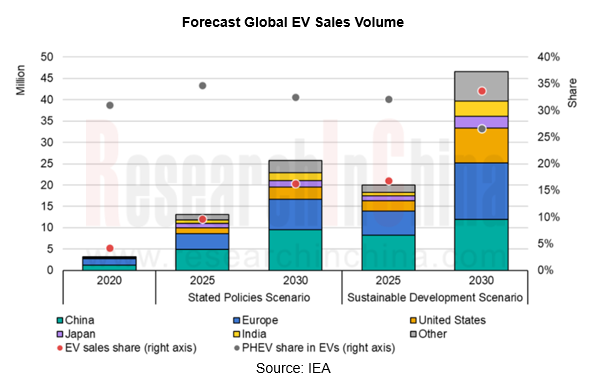
Under this background, government of each county fastens planning and construction of charging piles. Based on IEA’s statistics, number of EV charging infrastructures worldwide in 2020 amounted to 9.5 million units, including 2.5 million units public ones. Conservatively forecast, global EV charging infrastructures will increase to around 50 million units, including nearly 10 million units of public one.
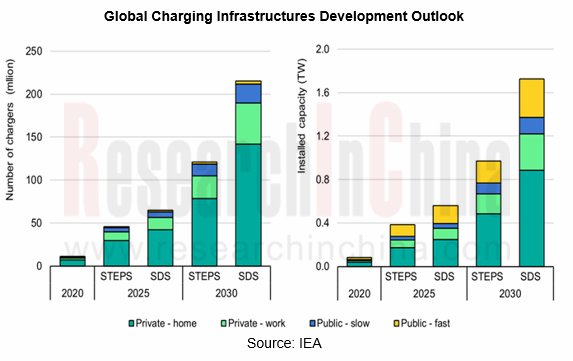
Currently, China’s charging pile ownership ranks first in the world. As of the end of 2020, China’s new energy vehicle ownership reached 4.92 million units, and number of charging piles amounted to 1.68 million units. Among them, number of private and commercial charging piles (including public and special) hit 874,700 units and 806,000 units, respectively, while car-to-pile ratio was 0.34 to 1.
It is estimated that China’s new energy vehicle ownership will amount to 17.82 million units by 2025 and number of charging piles will approximate 9.39 million units. Among them, number of private and commercial charging piles (including public and special) will hit 6.18 million units and 3.21 million units, while car-to-pile ratio will be 0.53 to 1.
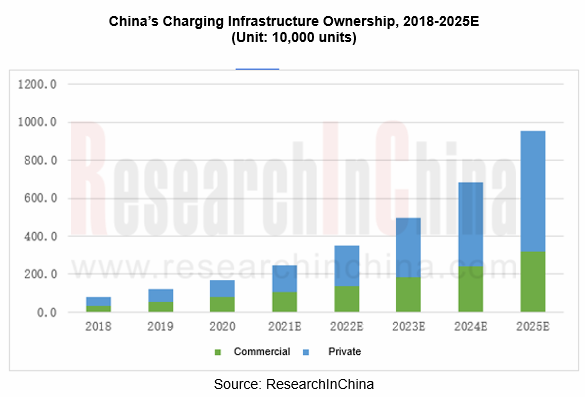
At present, China's highway fast charging network has basically taken shape, ranking first in the world. By 2020, a total of 2,251 charging stations and 9,065 charging piles have been built on 42 highways, with a service mileage of 54,000 kilometers, accounting for 35% of the total mileage of highways nationwide. According to the summary of bidding information for highway charging equipment of the State Grid over the years, highway charging piles are mainly 80 KW to 160 KW, and 240/480 KW super-power super-charging piles have been laid.
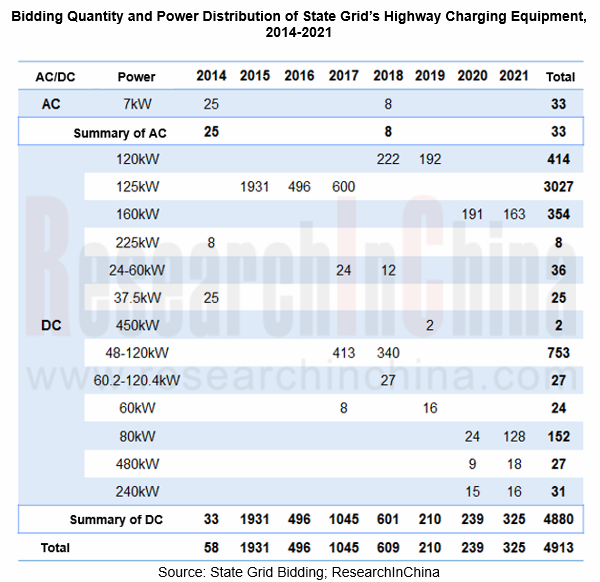
Medium and high-end intelligent EV brands vigorously layout charging network construction
Added value of intelligent EV brands has increased significantly, bringing about consumption upgrading in the automobile industry. Apart from intelligence and quality of the vehicles, charging quality improvement is also important. An article (Can the Battery Swap Mode that NIO and BAIC BJEV Both Bet on Overturn the industrial ecology?) released by ResearchInChina in August 2018 clearly pointed out that NIO builds a closed business scenario via battery swap mode to greatly enhance its brand value and service level, which is a very clever business strategy.
Many OEMs have also realized the importance of closed (or semi-closed) charging network. Medium and high-end start-up brands such as Tesla, NIO, Xpeng, Lixiang and other, as well as high-end EV brands of traditional OEMs, such as Geely ZEEKR, GAC Aion, BAIC ARCFOX, SAIC R, VW ID, etc., have begun or planned to layout in super charging station sector.
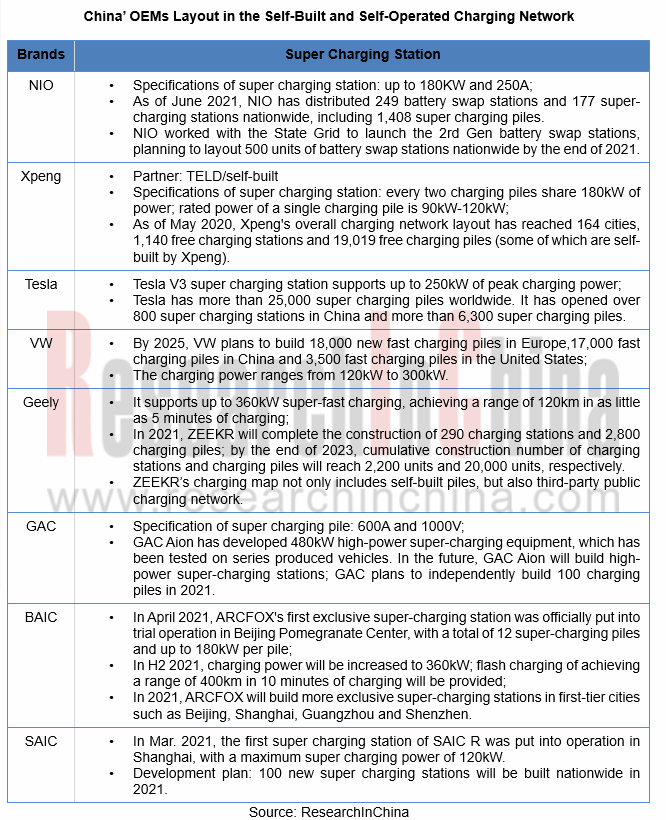
According to our analysis, OEMs currently mainly adopts three charging network construction and operation modes:
Mode 1: Fully self-built and self-operated "closed supercharging" system
This mode demands high costs and very high market ownership to maintain operation, represented by Tesla. In China, Tesla has laid a large number of charging piles. Although it has successively switched to the national standard interface, in fact Tesla's charging network is rarely open to the public, being a very closed charging network. Tesla has always claimed that it will allow to open super-charging piles to its peers, but we believe that the possibility of opening up in the short term is very small.
Tesla has built over 800 super charging stations and 6,300 super charging piles in China, supporting more than 710 destination charging stations, with charging network covering more than 290 cities. In 2021, its super charging pile factory in Shanghai was put into operation, with an initial planned annual production capacity of 10,000 units, mainly V3 super charging piles.
With extensive laying of Tesla's closed charging network, Tesla has actually formed a strong consumer barrier in China. Even if it faces many doubts in the short term, it will still occupy an important position in China in the long run. Its closed charging network has become one of the key factors for enterprises to achieve successful operation.
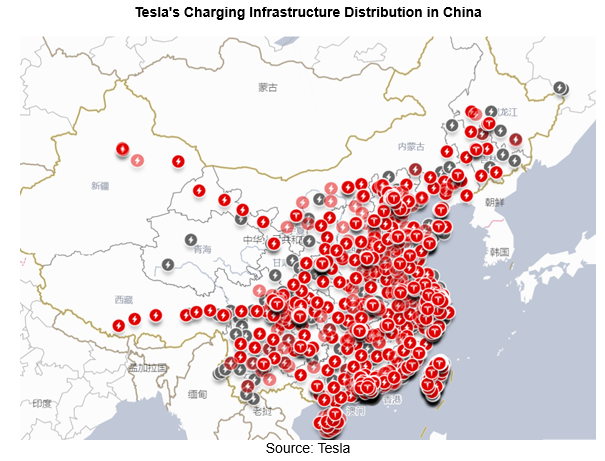
Mode 2: Fully self-built and self-operated "closed battery swap + open supercharging" system
Apart from supercharging station, battery swap station is also the main way for the charging layout of OEMs. NIO regards battery swap business as one of its core business models. It introduced car-electricity separation mode and led the establishment of Wuhan Weineng Battery Asset Co., Ltd. to be responsible for the management and operation of batteries.
In April 2021, NIO worked with State Grid to deploy the 2nd Gen of battery swap stations nationwide. Its brand-new battery swap technology supports the function of in-car one-button battery swap, eliminating the need of getting off the bus. Up to 312 battery swap services are provided every day, effectively improving battery swap efficiency.
As of June 2021, NIO has laid out 249 battery swap stations and 177 super-charging stations nationwide, including 1,408 super-charging piles. NIO partnered with State Grid to release the 2nd Gen battery swap station, planning to layout 500 units of battery swap stations nationwide. With the gradual improvement of NIO's car charging and battery swap network, we predict that NIO may properly lower the brand pricing to occupy the market of RMB 250,000 to RMB 350,000 range.
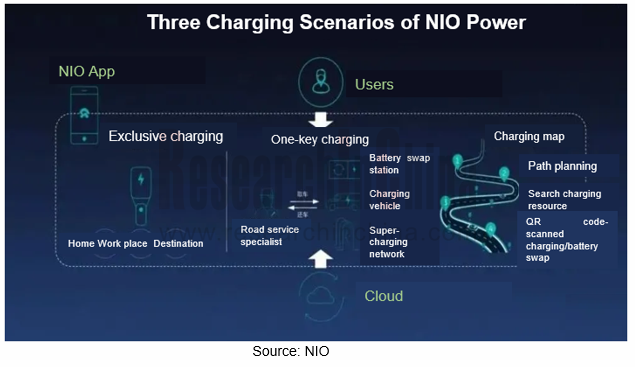
Mode 3: Cooperative "Open supercharge" system + partial self-built and self-operated "closed supercharge" system
Differed from the relatively closed charging network construction and operation modes of NIO and Tesla, Xpeng mainly cooperates with third-party operators such as TELD to build free supercharging network, greatly reducing network laying and operation costs.
In addition, Xpeng has also started the construction of its own-brand exclusive charging stations similar to those of Tesla and NIO so as to further upgrade charging brand service. By the end of 2021, Xpeng will plan to build over 500 units of branded super-charging stations. We expect that Xpeng will raise the price of its pure electric SUV to be released, and the closed charging network will be the key breakthrough point for enhancing its brand value.
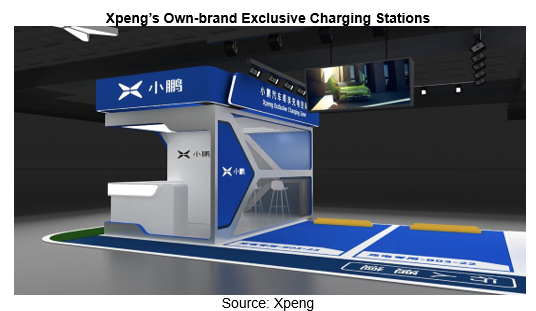
So far, Xpeng’s overall charging network layout has reached 164 cities, 1140 units of free charging stations and 19,019 free charging piles (some of which are self-built by Xpeng), expected to cover over 200 major cities nationwide by the end of 2021. Xpeng sales have surged since the release of its Lifetime Free Charging Plan (3,000 KWh per year) in Sept.2020.
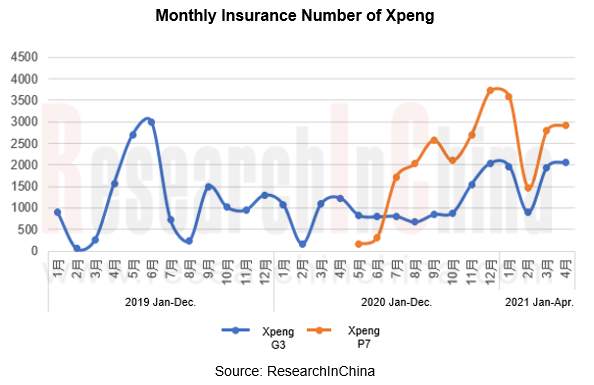
In addition, VW (China), FAW, JAC and Wanbang New Energy jointly established CAMS Kemeth, a charging operator, which adopts an operation mode similar to that of Xpeng, namely, a combination of open + partially closed (ground lock).
For other OEMs, we think that they are more likely to adopt mode 3. But each selects varied strategies and laying ideas. For instance, the newly released Geely ZEEKR is the first 800V platform model in China, supporting rapid charging at 360kW. It can drive 120km after just 5 minutes of charging. According to the plan, ZEEKR will complete the construction of 290 charging stations and 2,800 charging piles by 2021, and build 2,200 charging stations and 20,000 charging piles by the end of 2023. So far, ZEEKR’s fast charging network has not been officially unveiled.
In the future, with the promotion of 800V high-voltage fast charging architecture technology, it is a trend for both foreign-funded enterprises and independent brands to conduct product layout in high-voltage platform, and he self-built self-operated charging network of high-end intelligent EV brands will be accelerated.
Autonomous Driving Domain Controller and Central Computing Unit (CCU) Industry Report, 2025
Research on Autonomous Driving Domain Controllers: Monthly Penetration Rate Exceeded 30% for the First Time, and 700T+ Ultrahigh-compute Domain Controller Products Are Rapidly Installed in Vehicles
L...
China Automotive Lighting and Ambient Lighting System Research Report, 2025
Automotive Lighting System Research: In 2025H1, Autonomous Driving System (ADS) Marker Lamps Saw an 11-Fold Year-on-Year Growth and the Installation Rate of Automotive LED Lighting Approached 90...
Ecological Domain and Automotive Hardware Expansion Research Report, 2025
ResearchInChina has released the Ecological Domain and Automotive Hardware Expansion Research Report, 2025, which delves into the application of various automotive extended hardware, supplier ecologic...
Automotive Seating Innovation Technology Trend Research Report, 2025
Automotive Seating Research: With Popularization of Comfort Functions, How to Properly "Stack Functions" for Seating?
This report studies the status quo of seating technologies and functions in aspe...
Research Report on Chinese Suppliers’ Overseas Layout of Intelligent Driving, 2025
Research on Overseas Layout of Intelligent Driving: There Are Multiple Challenges in Overseas Layout, and Light-Asset Cooperation with Foreign Suppliers Emerges as the Optimal Solution at Present
20...
High-Voltage Power Supply in New Energy Vehicle (BMS, BDU, Relay, Integrated Battery Box) Research Report, 2025
The high-voltage power supply system is a core component of new energy vehicles. The battery pack serves as the central energy source, with the capacity of power battery affecting the vehicle's range,...
Automotive Radio Frequency System-on-Chip (RF SoC) and Module Research Report, 2025
Automotive RF SoC Research: The Pace of Introducing "Nerve Endings" such as UWB, NTN Satellite Communication, NearLink, and WIFI into Intelligent Vehicles Quickens
RF SoC (Radio Frequency Syst...
Automotive Power Management ICs and Signal Chain Chips Industry Research Report, 2025
Analog chips are used to process continuous analog signals from the natural world, such as light, sound, electricity/magnetism, position/speed/acceleration, and temperature. They are mainly composed o...
Global and China Electronic Rearview Mirror Industry Report, 2025
Based on the installation location, electronic rearview mirrors can be divided into electronic interior rearview mirrors (i.e., streaming media rearview mirrors) and electronic exterior rearview mirro...
Intelligent Cockpit Tier 1 Supplier Research Report, 2025 (Chinese Companies)
Intelligent Cockpit Tier1 Suppliers Research: Emerging AI Cockpit Products Fuel Layout of Full-Scenario Cockpit Ecosystem
This report mainly analyzes the current layout, innovative products, and deve...
Next-generation Central and Zonal Communication Network Topology and Chip Industry Research Report, 2025
The automotive E/E architecture is evolving towards a "central computing + zonal control" architecture, where the central computing platform is responsible for high-computing-power tasks, and zonal co...
Vehicle-road-cloud Integration and C-V2X Industry Research Report, 2025
Vehicle-side C-V2X Application Scenarios: Transition from R16 to R17, Providing a Communication Base for High-level Autonomous Driving, with the C-V2X On-board Explosion Period Approaching
In 2024, t...
Intelligent Cockpit Patent Analysis Report, 2025
Patent Trend: Three Major Directions of Intelligent Cockpits in 2025
This report explores the development trends of cutting-edge intelligent cockpits from the perspective of patents. The research sco...
Smart Car Information Security (Cybersecurity and Data Security) Research Report, 2025
Research on Automotive Information Security: AI Fusion Intelligent Protection and Ecological Collaboration Ensure Cybersecurity and Data Security
At present, what are the security risks faced by inte...
New Energy Vehicle 800-1000V High-Voltage Architecture and Supply Chain Research Report, 2025
Research on 800-1000V Architecture: to be installed in over 7 million vehicles in 2030, marking the arrival of the era of full-domain high voltage and megawatt supercharging.
In 2025, the 800-1000V h...
Foreign Tier 1 ADAS Suppliers Industry Research Report 2025
Research on Overseas Tier 1 ADAS Suppliers: Three Paths for Foreign Enterprises to Transfer to NOA
Foreign Tier 1 ADAS suppliers are obviously lagging behind in the field of NOA.
In 2024, Aptiv (2.6...
VLA Large Model Applications in Automotive and Robotics Research Report, 2025
ResearchInChina releases "VLA Large Model Applications in Automotive and Robotics Research Report, 2025": The report summarizes and analyzes the technical origin, development stages, application cases...
OEMs’ Next-generation In-vehicle Infotainment (IVI) System Trends Report, 2025
ResearchInChina releases the "OEMs’ Next-generation In-vehicle Infotainment (IVI) System Trends Report, 2025", which sorts out iterative development context of mainstream automakers in terms of infota...